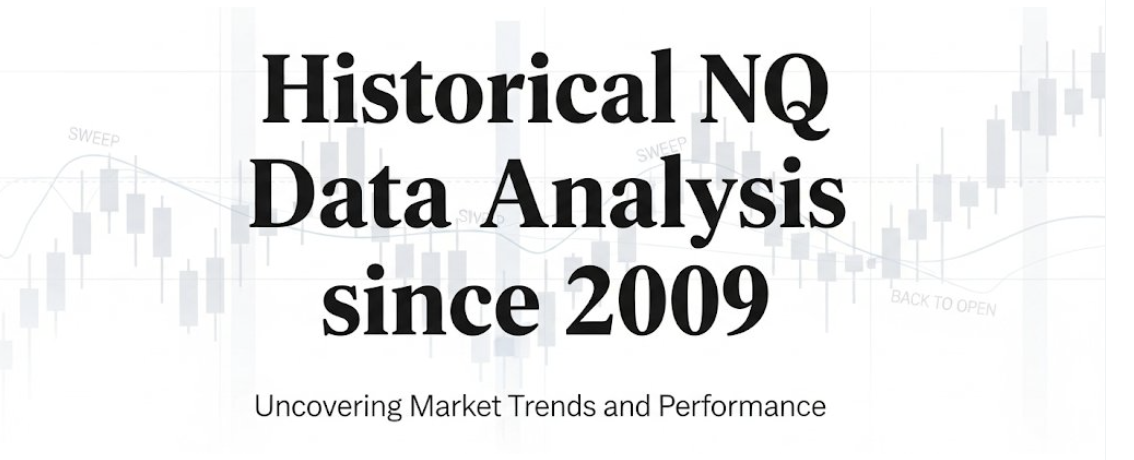Historical Sweep + Return to Open Study on 1H Candles [NQ]
Historical Sweep and Return to Open Study on Nasdaq Futures (NQ)
By Herman Trading
Introduction
This research investigates how the Nasdaq Futures (NQ) market behaves after a liquidity sweep.
The goal was to quantify, with statistical precision, how often price returns to either the next hour’s open or the 50% equilibrium of the previous hourly range.
The study is based on more than a decade of historical 1-minute data and translated into clear, repeatable metrics that can help traders understand when mean reversion is statistically more likely to occur.
Data and Methodology
Data source: BacktestMarket.com
Instrument: Nasdaq Futures (NQ)
Period covered: 2009 – August 2025
Resolution: 1-minute OHLC data
Timezone: Converted from Chicago Time (CT) to New York Time (ET)
Weekends: Excluded (Monday–Friday only)
Each data point includes date, time, open, high, low, close, and volume.
Because the dataset contains millions of rows, it was processed in Python using a chunked, memory-efficient workflow.
Analytical Framework
Python logic overview:
Resample data to hourly intervals.
Detect liquidity sweeps (breaks of the previous hour’s high or low).
Track whether price subsequently reverted to the previous hour’s open or 50% midpoint.
Aggregate all outcomes into summary tables and visual charts.
This approach preserves the precision of 1-minute data while analyzing market behavior through a higher-timeframe (1H) structure, which aligns with professional trading frameworks such as ICT’s killzones and session models.
Example Structure: Sweep and Return Logic
Each “range hour” (for example, 02:00–03:00 AM ET) defines a liquidity pool.
The following “trading window” (03:00–04:00 AM ET) is tested for:
A sweep of the previous hour’s high or low.
A subsequent reversion to the 3 AM open.
Or a reversion to 50% of the previous range (equilibrium level).
This framework quantifies a common market behavior observed during transitional or “killzone” hours, when liquidity is typically engineered before directional expansion.
Results Overview
The chart below shows the percentage of times price returned to the next hour’s open (blue) or 50% equilibrium (red) after a sweep, across all hourly ranges.
Statistical Summary
MetricValueSessions Analyzed4,291Sweep Occurred94.7%Return to 3 AM Open72.4%Return to 50% of Range58.4%
These numbers reveal a consistent mean-reversion tendency:
once a sweep occurs, there is roughly a 70% probability that price revisits the previous hour’s open, and a 58% probability of a return to equilibrium.
Interpretation and Use Cases
This dataset provides objective evidence of how often reversion occurs following liquidity sweeps.
Traders can integrate these probabilities in several ways:
Killzone Backtesting: Identify which hours historically show the highest reversion rates.
Directional Bias Filtering:
Sweep + Return → potential mean-reversion scenario.
Sweep without Return → likely continuation bias.
Mechanical Model Design: Convert the statistical tendencies into structured rules.
Entry Confirmation: Validate trade ideas around session opens (e.g., 3 AM or 8 AM New York time).
Why It Matters
This study demonstrates how quantitative methods can confirm behavioral patterns often discussed in discretionary trading communities.
Instead of speculation, traders gain data-driven confirmation of when price is most likely to revert after a sweep.
It bridges statistical analysis and market structure — a key step toward mechanical consistency in trading.
Data over opinion. Precision over prediction.
Technical Notes
Programming Language: Python (pandas, numpy, matplotlib)
Dataset Handling: Incremental parsing of large CSV files
Output: Tabular summaries and visualization of hourly return probabilities
Time Alignment: Converted to ET to match institutional session timing
Symbol Tested: Nasdaq Futures (NQ)
Conclusion
The findings highlight a measurable probabilistic edge that can be incorporated into professional trading models.
Mean reversion after a sweep is not random — it is a repeatable pattern backed by statistical evidence.This study is part of the Herman Trading Research Series, designed to merge quantitative testing with practical trading logic.
For ongoing updates and further studies, visit:
hermantrading.pro
and follow @R_Herman_ on X.




